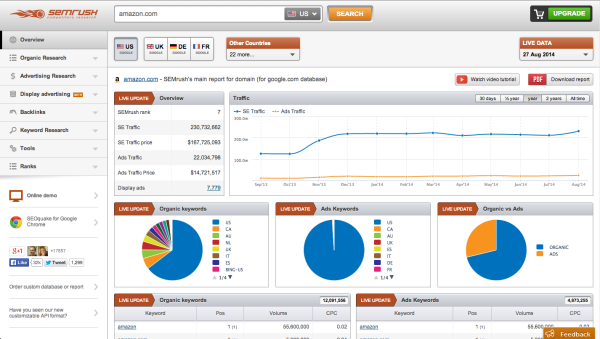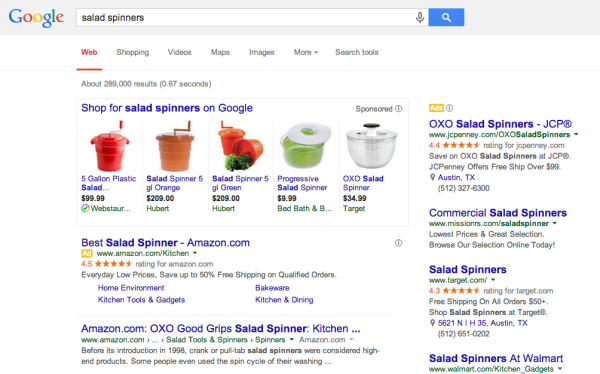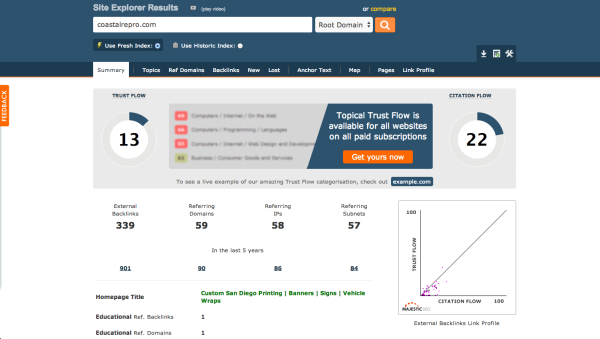Content is being created online at every increasing speed. The barrier to entry for creating an online business is getting lower. More competitors are entering more industries all the time. As a business with any sort of decent web presence, you have to be on your toes at all times, catching up to your strongest competitors and staying ahead of new entrants.
Thankfully there are lots of online tools to help you stay ahead of the pack. A lot can be discovered about your competitors’ digital strategies in just 15 minutes with the right playbook and the right tools to get the job done. Here is the 15-minute strategy.
Minutes 0 to 5 – SEMrush Analysis
SEMrush allows you to quickly analyze any website and gives you more organic and paid search keyword data than any other tool out there.

- Jump over to SEMrush and on the home page, simply enter your #1 online competitor’s URL.
- Under traffic, glance at the performance of their organic and ads search traffic under the ‘Traffic’ box. Look for big dips and increases.
- Underneath that box, look for the organic to ads ration pie chart and how this compares to other in the industry.
- Look at the organic keywords box and notice the number and quality of keywords they’re ranking for. How does this compare to your website and others in the industry?
- Looking below that box, who are the “Top competitors in organic search”? Is this what was expected?
You can spend hours digging deeper into SEMrush, but just this initial overview page gives you tons of data for free.
Minutes 6 to 10 – Google Search Results
No explanation needed for Google search, other than the fact that it’s important not to forget about it as a tool itself. Instead of relying only on 3rd party tools, search your main keywords in Google often to get a feel for the search results and how they change over time.

- Take five of the top keywords from your competitor’s SEMrush results and do individual Google searches.
- Across the five searches, what websites are ranking the most often? What trends do you see?
- Are there many Adwords ads for the keywords you’re searching? If not, why?
- Note if there are any rich snippets such as videos, star ratings, or carousel search results
Minutes 11 to 15 – MajesticSEO
MajesticSEO is big in the SEO industry for large scale link analysis, but it also informs just how visible your competitors are online and what strategies they’re using for promotion.

- Enter your competitor’s URL – and notice the Citation Flow and Trust Flow. This is on a scale of 0-100 and you don’t want the Citation Flow to be too much of a different number from Trust Flow.
- Look just below at the ‘External Backlinks’ and ‘Referring Domains’ – the number of referring domains is more important than external backlinks. The higher the better if they are quality links. If you are going to beat your competitors online, beating their referring domains is important.
- Looking at their Backlink History, do they consistently get new links? Unnatural spikes are worth looking into, but spikes can be natural too.
- Look at the ‘Anchor Text’ box – if their top anchor texts are commercial keywords, they might be guilty of manipulative SEO and could be facing a penalty or are already under one.
- Lastly, look at their list of top backlinks – the more reputable the site is that’s sending them links, the better. Look for links that you can potentially acquire for your site.
As with SEMrush, you could spend a week in MajesticSEO and just scrape the surface. It’s a great tool for content inspiration, and for one client we produced an infographic for small businesses based on this research. Find what your competitors have done and do it better.
Putting It All Together
Whether presenting to a client or to company stakeholders, take a lot of screenshots of what you’re seeing and put it all together into a comprehensive story.
This 15-minute strategy is good for quick analysis and surveying the landscape, but of course you’ll need to spend much more time on analysis to really understand the competition. So once you’ve got this done, roll up your sleeves, dig deeper, and get it done.